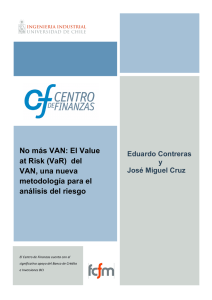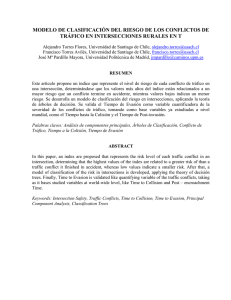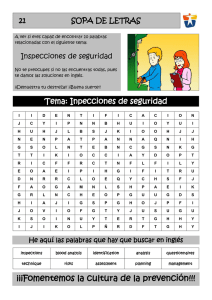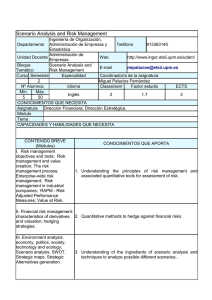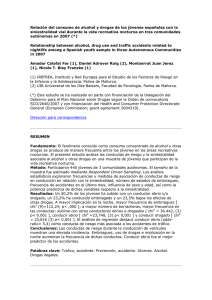PERCEPCIÓN DEL RIESGO:
Anuncio
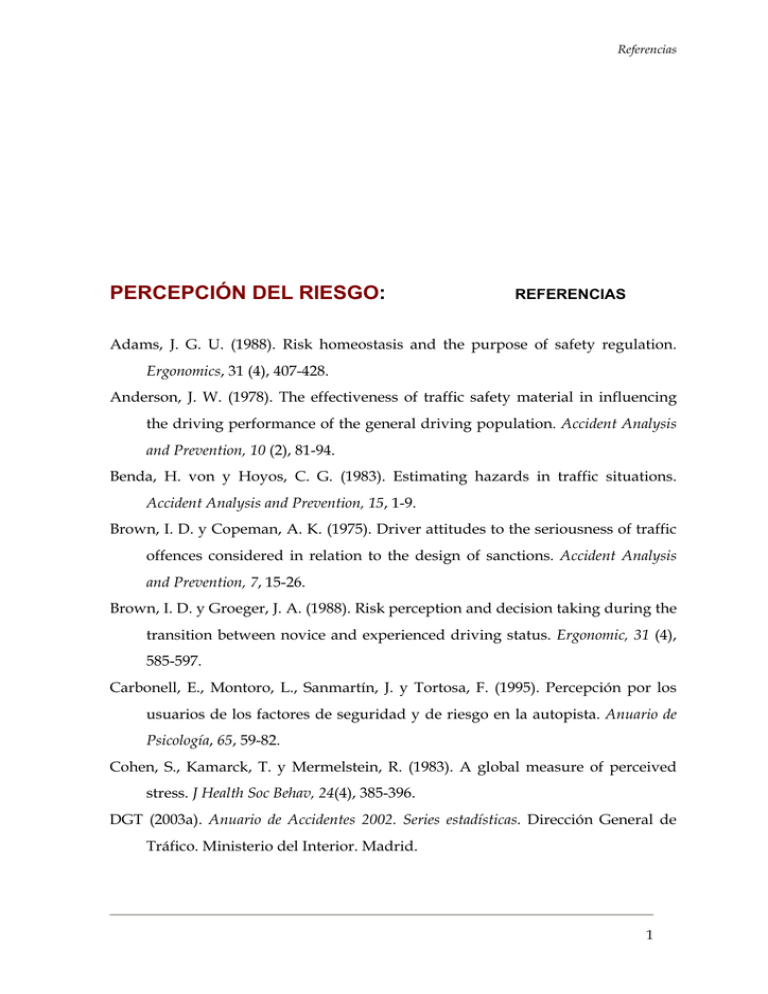
Referencias PERCEPCIÓN DEL RIESGO: REFERENCIAS Adams, J. G. U. (1988). Risk homeostasis and the purpose of safety regulation. Ergonomics, 31 (4), 407-428. Anderson, J. W. (1978). The effectiveness of traffic safety material in influencing the driving performance of the general driving population. Accident Analysis and Prevention, 10 (2), 81-94. Benda, H. von y Hoyos, C. G. (1983). Estimating hazards in traffic situations. Accident Analysis and Prevention, 15, 1-9. Brown, I. D. y Copeman, A. K. (1975). Driver attitudes to the seriousness of traffic offences considered in relation to the design of sanctions. Accident Analysis and Prevention, 7, 15-26. Brown, I. D. y Groeger, J. A. (1988). Risk perception and decision taking during the transition between novice and experienced driving status. Ergonomic, 31 (4), 585-597. Carbonell, E., Montoro, L., Sanmartín, J. y Tortosa, F. (1995). Percepción por los usuarios de los factores de seguridad y de riesgo en la autopista. Anuario de Psicología, 65, 59-82. Cohen, S., Kamarck, T. y Mermelstein, R. (1983). A global measure of perceived stress. J Health Soc Behav, 24(4), 385-396. DGT (2003a). Anuario de Accidentes 2002. Series estadísticas. Dirección General de Tráfico. Ministerio del Interior. Madrid. 1 Referencias DGT (2003b) Notas de prensa. Desciende casi un 3% la siniestralidad en carretera durante el año 2002. Dirección General de Tráfico. Ministerio del Interior. Madrid. Douvan, E. (1974). Commitment and social contract in adolescence. Psychiatry, 37, 22-36. Dreyer, D. y Janke, M. (1979). The effects of range versus nonrange driver training on the accident and conviction frequencies of young drivers. Accident Analysis and Prevention, 11, 179-198. Evans, L. y Wasielewsky, P. (1982). Do accident-involved drivers exhibit riskier everyday driving behaviours? Accident Analysis and Prevention, 14, 57-64. Fuller, R. (1984). A conceptualization of driving behaviour as threat avoidance. Ergonomics,27(11), 1139-1155. Gras-Pérez, Mª. E. (1994). Efecto de las pérdidas y ganancias recientes en el riesgo asumido por los automovilistas. Psicothema, 6(2), 123-137. Guerin, B. (1994). What do people think about the risks of driving? Implications for traffic safety interventions. Journal of Applied Social Pychology, 24, 994-1021. Haight, F. A. (1986). Risk; especially risk of traffic of accident. Accident Analysis and Prevention, 18, 359-366. Harvey, C. F., Jenkins, D. y Sumner, R. (1975). Driver error. U.K. Dept. of the Environment, T.R.R.L.Supplementary Report 149UC. Hoyes, T. W., Dorn, L., Desmond, P. A. y Taylor, R. (1996). Risk homeostasis theory, utility and accident loss in a simulated driving task. Safety Science, 22 (1), 49-62. Huguenin, R. D. (1988) The concept risk and behaviour models in traffic psychology. Ergonomics, 31 (4), 557-569. Janssen, W. y Tenkink, E. (1988). Risk homeostasis theory and its critics: time for an agreement. Ergonomics, 31 (4), 429-433. Jonah, B. A. (1986). Accident risk and risk-taking behaviour among young drivers. Accident Analysis and Prevention, 18, 255-271. 2 Referencias Matthews, M. L. y Moran, A. R. (1986). Age differences in male drivers’ perception of accident risk: the role of perceived driving ability. Accident Analysis and Prevention, 18, 229-313. Maythew, D. R., Donelson, A. C., Bierness, D. J. y Simpon, H. M. (1986). Youth, alcohol and relative risk of crash involvement. Accident Analysis and Prevention, 18, 273-287. McKenna, F. P. (1988). What role should the concept of risk play in theories of accident involvement? Ergonomics, 31 (4), 469-484. Montoro, L., Alonso, F., Esteban, C., y Toledo, F. (2000). Manual de seguridad vial: El factor humano. Ariel Intras: Valencia. Näätänen, R. Summala, H. (1974). A model for the role of motivational factors in drivers´decision-making. Accident Analysis and Prevention, 6(3-4), 243-261. Oppe, S. (1988). The concept of risk: a decision theoretic approach. Ergonomics, 31 (4), 435-440. Ortet, G., Ibáñez, M. I., Moro, M. y Silva, F.( 1997). Cuestionario de personalidad de Eysenck-revisado. Madrid: TEA. Sabey, B. E. y Taylor, H. (1980). The known risks we run: the highway. U.K. Dept. of the Environment, Dept. of Transport, T.R.R.L. Supplementary Report 567. Simonet, S. y Wilde, G. J. S. (1997). Risk: Perception, acceptance and homeostasis. Applied Psychology: An Internartional Review, 46 (3), 235-252. SPSS, Inc. (1999). SPSS for windows (Version 10.0). Chicago: Author. Stetzer, A. y Hofmann, D. A. (1996). Risk compensation: Implications for safety interventions. Organizational Behavior and Human Decision Processes, 66 (1), 7388. Svenson, O. (1978). Risks of road transportation in a psychological perspective. Accident Analysis and Prevention, 10(4), 267-280. Svenson, O. (1981). Are we all less risky and more skillful than our fellow drivers? Acta Psychologica, 47(2), 143-148. Toledo, F. y Alonso, F. (1997). El comportamiento humano en la conducción: Modelos explicativos. En F. Toledo (Ed.), El factor humano en la conducción de 3 Referencias trenes: Manual de conducción segura (pp. 69-90). Valencia: Línea editorial INTRAS. Wilde, G. J. S. (1982). The theory of risk-homeostasis: Impllication for safety and health. Risk Analysis, 4, 209-225 Wilde, G. J. S. (1988). Risk homeostasis theory and traffic accidents: propositions, deductions and discussion of dissension in recent reactions. Ergonomics, 31 (4), 441-468. Wilde, G. J. S. (2001). Riesgo deseado? El comportamiento humano ante el peligro. Versión al español: L. D. Ramírez. México City: Asociación Mexicana de Higiene y Seguridad. Wilde, G. J. S. y Murdoch, P. A. (1982). Incentive systems for accident-free and violation-free driving in the general population. Ergonomics, 25, 879-890. Wilde, G. J. S., Robertson, L. S. Y Pless, I. B. (2002).For and against: Does risk homeostasis theory have implications for road safety. BMJ, 324 (7346), 11491152. 4
